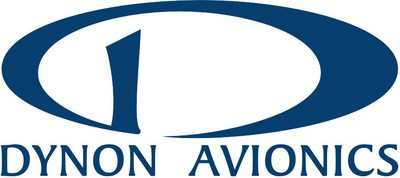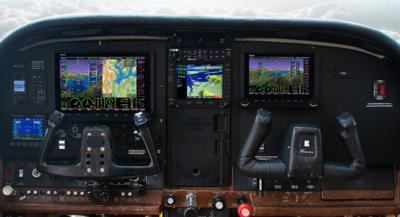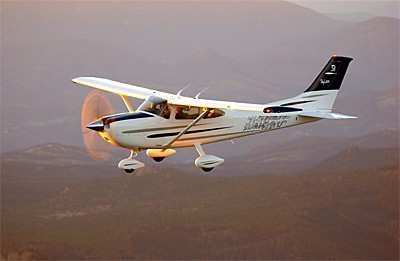Improving Upon Greatness?
Founded as a joint-venture between a semiconductor entrepreneur and a pilot, Dynon is a respected designer and manufacturer of light aircraft avionics. In October 2022, the company announced its SkyView autopilot system had received FAA approval for installation in Cessna 182E thru 182T, R182, T182, TR182, and T182T Skylane models equipped with Dynon’s SkyView HDX avionics system—a complete and highly-capable integrated avionics system for light, light-sport, and experimental aircraft.

The SkyView Autopilot integrates with the SkyView HDX suite to provide pilots automated control of their airplanes in the pitch and roll axes. Aviators may command the autopilot to follow a pre-defined flight-plan, fly direct-to a waypoint, VOR, or airport, and turn to and maintain the headings or tracks of their preference. The SkyView autopilot will also climb or descend to and maintain preselected altitudes by reference to either vertical-speed or indicated airspeed.
In addition to its enroute functions, the SkyView autopilot is capable of flying any instrument precision or non-precision approach—provided the aircraft is equipped with a compatible third-party IFR navigation device.
The standard SkyView autopilot interface consists of an on-screen control menu accessed by simply touching (touch-screen) the AP Status Bar displayed in perpetuity on the HDX avionics system’s Primary Flight Display (PFD). When the autopilot is not engaged, the AP Status Bar will be empty—excepting the letters “AP” displayed in white. Conversely, when the autopilotis engaged, the AP Status Bar will provide autopilot status information such as Roll Mode (heading), Pitch Mode (altitude), and pilot-targeted vertical speed for altitude changes.

Pilots may use the SkyView autopilot’s control mode guidance to fly their aircraft manually by simply following the flight-director command bars displayed on the HDX avionics system’s Primary Flight Display (PFD). The autopilot enforced limits on airspeed and G-loading are honored by the flight-director. For example, if a descent rate is selected that reaches the maximum autopilot operation speed, the flight director will indicate a pitch up to reduce speed and limit descent rate.
To fly manually with the flight director on, pilots need only set the SkyView autopilot control menu to the desired parameters, then—as opposed to pushing the AP button—instead push the FD button. So commanded, the flight-director will describe aircraft attitudes conducive to the execution of the programmed flight-path. The pilot, thereafter, has but to put the roof on the proverbial house—which is to say, maneuver the airplane to match the flight director queues displayed on the PFD.
Dynon’s SkyView provides pilots a choice between chevron and cruciform flight director styles.
While the SkyView’s digitally displayed autopilot control menu can be used to operate the autopilot, an assortment of optional instrument panel-mounted controls are also available. These dedicated control panels, available in both horizontal and vertical layouts, provide the same controls as the digital interface. The principal benefit of the “hard” autopilot control panels is that it affords pilots direct button access to the entirety of the autopilot's control modes without having to first open the autopilot menu on the PFD.
Hard controls are also available for critical functions such as autopilot disconnect and autopilot level. It is recommended that an autopilot disconnect button be mounted to the aircraft’s control yoke or stick. If this is not possible, the aforementioned autopilot disconnect button may be substituted to perform this function. At least one autopilot disconnect button of some form must be installed.
The autopilot level function is activated/deactivated via a panel-mounted button, and serves to return the aircraft to straight-and-level flight in the event of uncommanded upset, inadvertent unusual attitude, or pilot disorientation.

Pressing the level button (or Straight-and-Level Mode) will immediately prompt the autopilot to pitch the airplane to zero vertical speed and roll it to zero degrees of bank. The function will not attempt to fly the airplane to any previous altitude, heading or track, and will disregard bug inputs. Rather, Straight-and-Level Mode simply—but reliably—maintains level pitch and bank attitudes on the heading and altitude at which recovery was commanded. When activated, Straight-and-Level Mode will engage the Autopilot if it was not previously engaged.
Dynon Certified products, including the SkyView autopilot system, may be purchased and installed by any Dynon Authorized Installation Center. Alternately, pilots may acquire Dynon-Certified equipment directly from Dynon, and have such installed in their aircraft by a qualified third-party.
 Airborne-Flight Training 05.09.24: ERAU at AIAA, LIFT Diamond Buy, Epic A&P
Airborne-Flight Training 05.09.24: ERAU at AIAA, LIFT Diamond Buy, Epic A&P ANN's Daily Aero-Term (05.07.24): Hazardous Weather Information
ANN's Daily Aero-Term (05.07.24): Hazardous Weather Information Aero-News: Quote of the Day (05.07.24)
Aero-News: Quote of the Day (05.07.24) NTSB Final Report: Cessna 150
NTSB Final Report: Cessna 150 Aero-News: Quote of the Day (05.08.24)
Aero-News: Quote of the Day (05.08.24)





